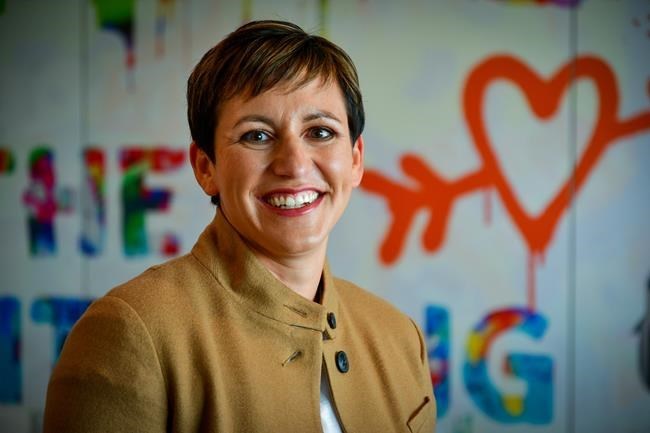CALGARY — It's been eight years since Canadian securities regulators instituted so-called comply-or-explain rules in an effort to increase the number of women in the nation's corporate boardrooms and executive offices.
Kelly Schmitt, one of Canada's few female chief executives, does not mince words when asked what she thinks about the latest round of data showing 66 per cent of publicly traded companies in Alberta have one or more women in executive officer positions.
"That's pathetic," said Schmitt, CEO of Calgary-based tech firm Benevity. "And the 'one or more' sounds like having 'one' is enough. Is that really the bar we're setting?"
Canada-wide, the statistics aren't much better, with only 70 per cent of companies listed on the Toronto Stock Exchange reporting at least one women executive officer.
Since 2014, companies listed on the TSX have been required to either disclose, or explain why they can't disclose, their progress in getting more women around their board table or into their company's C-Suites.
Some progress has been made. The 2022 numbers, released by the Canadian Securities Administrators (CSA) last month, show that 24 per cent of corporate board seats in Canada are occupied by women, up from 11 per cent when "comply or explain" requirements began.
The statistics also show that 61 per cent of publicly traded companies now have a policy related to the representation of women on their board, compared to just 15 per cent of companies in 2014. In 2022, 45 per cent of corporate board vacancies were filled by women (a 10 per cent increase from 2021).
But when it comes to the C-Suite, less progress has been made. Only five per cent of TSX issuers had a female CEO in 2022, a number that has barely budged since the first year of data collection. And only four per cent of issuers have adopted any targets for gender diversity at the executive level, just a fraction of the 39 per cent who have set gender diversity targets for their boards.Â
"My personal opinion is getting the board’s composition diverse is actually the easy part," said Schmitt, who is one of five female members of Benevity's nine-person executive team. "Getting more women in the C-Suite is harder.”Â
Women leaders are as likely as men at their level to want to be promoted and aspire to senior-level roles, according to a recent report from McKinsey & Company and LeanIn.org, which surveyed companies in both the U.S. and Canada.
But the report also found that women are far more likely to report headwinds that prevent them from advancing in their careers. Women leaders are far more likely than men in leadership to have colleagues imply that they aren’t qualified for their jobs. And women leaders are twice as likely as men leaders to be mistaken for someone more junior.Â
Women leaders are also more likely to report that personal characteristics, such as their gender or being a parent, have played a role in them being denied or passed over for a raise or promotion, according to McKinsey.Â
At Benevity, 54 per cent of the total work force are women, and 59 per cent of lateral moves or promotions at the company in the last year were awarded to women. Schmitt said those statistics didn't come about by accident.
"Benevity never set targets to get here, but we do focus on behaviours that drive diversity," she said. "We hire women who are expecting, we promote women who are on parental leave, we have programs that give co-parenting bonuses to men who share parental leave with their partners."
"In our recruiting process, we have goals that ensure that, particularly for senior leadership roles, the funnel of candidates is a diverse set of candidates," she added.Â
Pipeline giant Enbridge Inc., which won an award from the global non-profit Catalyst earlier this year for its work increasing women's representation and inclusion across its work force, introduced a "diversity dashboard" in 2017 that tracks women's participation at all levels of the company and makes that information available to all employees.
The company's director of talent management, Lisa Barrett, said that tool has been key in helping the company increase the proportion of women at the manager level from 27 to 35 per cent, and at the executive level from 25 to 33 per cent.Â
"The key is to have the information – to be clear about what the talent gaps are and then set a plan to close them," Barrett said, adding that while the oil and gas sector has traditionally been more male dominated than other industries, programs like Enbridge's Women in Technology program and Women in Leadership program have made a demonstrable difference.
The McKinsey report said that retaining women executives is also a challenge, and points out that since the COVID-19 pandemic, women leaders are leaving their companies at a much higher rate than male leaders. It singles out flexibility — whether in terms of work location or hours — as the number one thing companies can do to retain their female leaders.
Schmitt agrees, adding one of the reasons Benevity hasn't forced its employees back to the office in the wake of lifted public health restrictions is because it felt such a move would disproportionately affect women.
Ultimately, attracting and retaining women leaders comes down to recognizing that employees — all employees, not just women — are human, Schmitt said.Â
"You have to have a level of empathy and understanding to design work in a way that benefits the company and community of people that work here, but also allow people to design their lives in a way that serves them too," Schmitt said.
This report by The Canadian Press was first published Nov. 18, 2022.
Companies in this story: (TSX:ENB)
Amanda Stephenson, The Canadian Press



